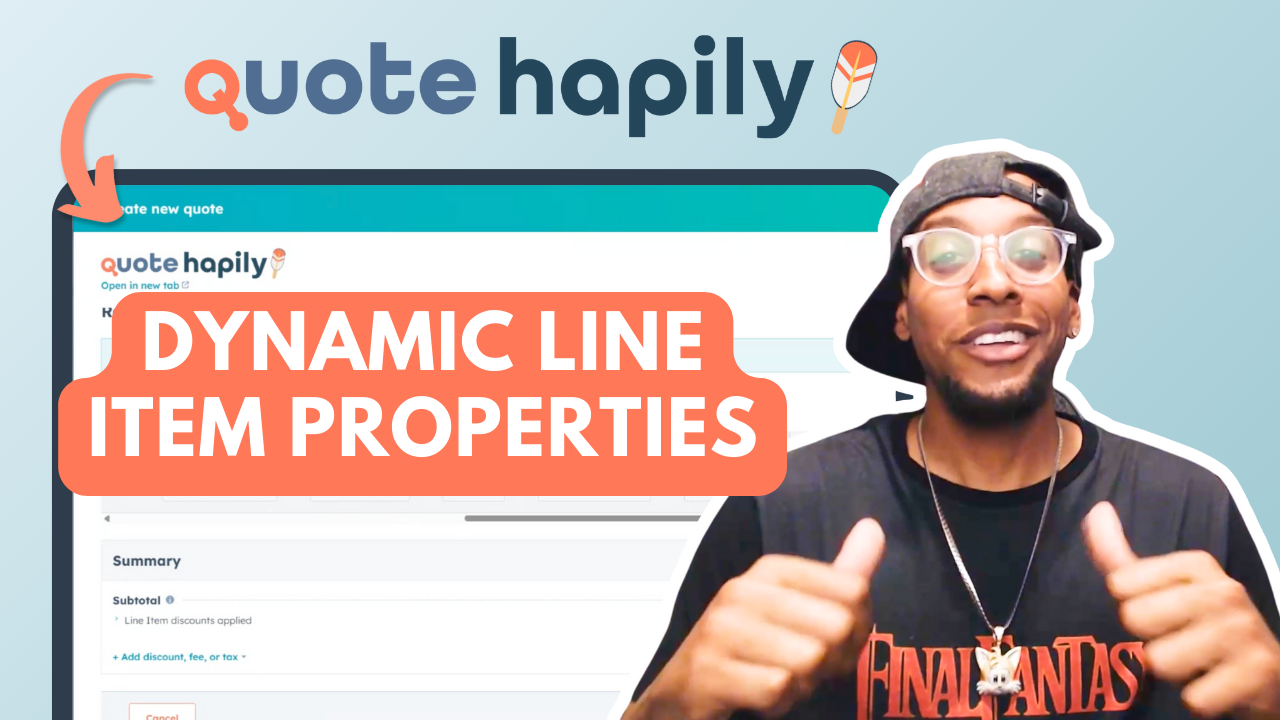Sales reps want speed. Ops teams want control. Finance wants accuracy. And when quoting in HubSpot, it’s easy for those priorities to clash — especially when you rely on reps to manually apply discounts, remember promo rules, or enforce guardrails on the fly.
That’s where dynamic line item properties in quote•hapily come in.
This feature gives you the ability to define logic-driven rules that control how quote line items behave based on deal context — without needing your reps to do anything manually.
It’s automation that aligns every quote with the strategy behind it.
Want the TL;DR version instead? Watch Dax dive into it here:
What Dynamic Line Item Properties Are — and Why They Change the Game
At their core, dynamic line item properties let you attach conditions to individual line item fields — things like price, discount %, term length, or whether a field is editable. When those conditions are met, quote•hapily enforces your logic automatically.
You’re not just templating quotes. You’re dynamically adapting each one based on the specific deal.
That means you can:
- Apply the right discount, only during a valid promo period
- Lock down fields so reps can’t fudge numbers to get a deal through
- Add or hide products based on buyer type, region, or industry
- Auto-bundle offerings without manual intervention
- Govern your quoting strategy at scale, without adding friction
The result? Faster quotes that follow your rules — every time.
Let’s Get Specific: The “Blue Light Special” Example
Imagine you're running a limited-time discount on certain products in your catalog. Instead of sending a Slack message to your reps and hoping they apply the right discount (and only during the valid timeframe), you can build a simple rule:
- Condition 1: Product Name contains “Blue Light Special”
- Condition 2: Quote created between April 1 and April 30
- Action: Apply 20% discount
- Action: Lock discount field so it can’t be edited
With this in place, every quote that includes a “Blue Light Special” during that window automatically reflects the discount — and reps can’t override or forget it.
It's built-in promo enforcement without relying on memory or manual QA.
Digging Deeper: Practical Use Cases
Dynamic line item properties are versatile — and their value scales with your quoting complexity. Here are a few scenarios where they shine:
1. Segment-Based Pricing and Access Control
Selling across different geographies or industries? Set rules that apply unique discounts or restrict products based on region, industry tag, or deal owner. Reps only see what they’re allowed to quote — and pricing is adjusted behind the scenes.
2. Promo Logic That Doesn’t Break
Build time-bound promotions that activate and expire automatically. You’re not managing templates or chasing reps — the logic enforces itself. Pair it with approval rules or NPS follow-up workflows to keep your entire funnel aligned.
3. Locked Fields for Compliance
You’ve set the pricing strategy. Now you need to protect it. Mark fields like "Unit Price" or "Discount" as read-only so reps can’t bypass the rules to make a deal look better than it is. This is key for teams subject to margin requirements or regulatory restrictions.
4. Triggered Bundles and Add-Ons
Sell a product that always comes with a specific implementation or training package? Use logic to automatically add those line items to the quote — no checklist or rep memory required. Better CX, more consistency, and zero missed revenue.
Setting It Up: How It Works in Practice
Here’s how to put dynamic line item properties into motion:
1. Define Your Triggers
Think about the data that should drive a change:
- Product Name
- Deal Stage
- Close Date
- Deal Type
- Lifecycle Stage
- Custom properties
2. Define the Property Changes
What happens when the condition is met?
- Apply a discount
- Change billing frequency
- Mark a field as read-only
- Add a companion product
3. Test in Real Scenarios
Run quotes in sandbox or test environments to make sure rules fire correctly. Start simple and layer on complexity only as needed.
4. Document and Share the Logic
As with any powerful automation, documentation is key. Make sure your sales and ops teams understand how the rules work, what’s happening automatically, and where exceptions (if any) apply.
What This Actually Solves
This isn’t just about making your quote prettier — it’s about fixing the real friction points between sales, ops, and finance:
- No more “I thought that product had a discount”
- No more margin-slashing manual overrides
- No more templates that don’t account for the actual deal
- No more post-send clean-up when someone catches an error too late
You’re giving your team quoting guardrails that don’t slow them down. And that’s rare.
When You’re Ready to Get Serious About Quoting …
Dynamic line item properties are one of those features that feel small until you start using them — and then you wonder how you ever sent a quote without them.
They’re flexible, powerful, and completely native to your HubSpot quoting experience with quote•hapily.
Set the rules once. Let the system enforce them. And finally stop crossing your fingers every time a quote goes out.
👉 See it in action! Request a demo to see how they can transform the way you quote, sell, and grow.



.png)
